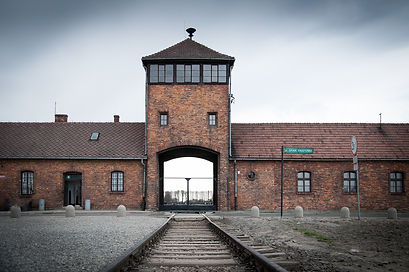Teaching the Holocaust
Considerations on New Approaches for Holocaust Education
Joseph and Myra Brandman Virtual Holocaust Memorial Museum
How do we teach the Holocaust in a meaningful way? This is a question I have grappled with over the years and my answers have ranged from my Weimar and Nazi Germany role-play, to primary source analysis, to film-heavy units. I invite you to visit my newly inaugurated virtual museum honoring my grandparents. It is filled with the best sources on the Holocaust, a museum guide, videos clips, historiography discussions, and my grandparents own stories gleaned from their testimonies.
Why do I use my grandfather's Holocaust Testimony in my class? Besides our family connection, I think there is something relatively unique in his story. Within Holocaust education, we tend to focus on the experience of German Jews, including the Nuremberg Laws and Kristalnacht, as well as the horrors of Auschwitz. This narrative leaves out, however, a vast array of experiences, including those of the Baltic Jews like my grandparents.
My grandfather's story, which began in Riga, Latvia, includes one of the most horrific one-day massacres by the Einsatzgruppen during the genocide, which is now known as the Rumbula Massacre. It is important that we gain a better understanding of these firing squad massacres, as historians now recognize that more Jews died in such a manner than at Auschwitz. In those two days, he lost most of the members of his family, including his mother, two younger sisters, and his pregnant wife.
His story also reveals some of those unknown (or forgotten) examples of resistance that failed to achieve their goals but demonstrate remarkable courage. He speaks of the Riga ghetto uprising in which Jewish policemen smuggled in weapons, only to be discovered and executed. He speaks of stealing vegetables and tobacco only to have the other "thieves" hung in front of everyone while he managed to escape notice. And he speaks of his one attempt to escape with my grandmother, only to return because of the risks of the forest. His brother, who did not, died in the woods at the hands of the SS.
His story does include one of the mostly unknown death camps and its gas chambers: Stutthof. He describes a death march. He talks of the despair of losing loved ones and the strange experiences of humanity, such as meeting my grandmother and falling in love. And then he ends with one of the most gripping tales of liberation: with the Soviets and British closing in, the Nazis load Jews on a boat and blow it up. He and my grandmother avoid the trap and instead hear the sound of a British rescuer saying "You don't need to be afraid of the Germans anymore."
His video is also a prime opportunity to work on the historical thinking skill of sourcing. While we should, of course, believe the overall story of any survivor, in an oral history we must be careful about what can truly be remembered after 60 years. We discuss the problems of memory and what we can accept as "true" and what parts of the story, like dialogue, might be true in a sense while the details are recreated. Will he tell the story differently because I am his grandson than he would to a stranger?
I also show them how we can corroborate his stories with other sources. After he discusses the Rumbula Massacre or the Riga Ghetto resistance, a quick check on the internet links here show the strength of his memory -- correct to the date. In fact, I bring up that my grandfather is an unusual source for an oral history because of his remarkable memory. He was featured in a book because of his incredible memory, his obituary mentions it, and his family remembers how at age 93 he named everyone's birthday in the family, including my sister's dog. His recall of detail extends to his describing the 14 gold coins he held onto from a Nivea creme box.
My grandfather, however, gets one major fact wrong. He describes how on the day of liberation the Nazis blew up a boat with 7,000 people in it. He calls the boat the Capricorn. Many times, I attempted to corroborate this story, with no luck. I tried different spellings of the boat. I couldn't find it. The story seemed almost too incredibly brutal and tragic. Then I found out the story is even more tragic. I managed to identify the boat as the SS Cap Arcona, a luxury cruise liner transformed by the Nazis into a prisoner barge. They did, indeed, load it up with Jews and political prisoners and send it out into the waters. It did blow up. But they didn't do it. On the same day the British liberated Stuthoff, they also blew up the boat and killed 5,000-7,000 innocent prisoners. It appears, tragically, that they thought the boat was filled with Nazis attempting to escape, and thus they sent it to the bottom of the waters.
What does the story mean as historians? We must believe the survivor's story, we must connect to it, we must remember it. In the case of my grandfather, we can even believe details told 60 years later. But he didn't get it all right. It was logical for him to believe the Germans blew up the boat. Why would he think the British did it? But even those in the midst of the story aren't always privy to all the information we have on hand decades later.
Thank you, Grandpa.
